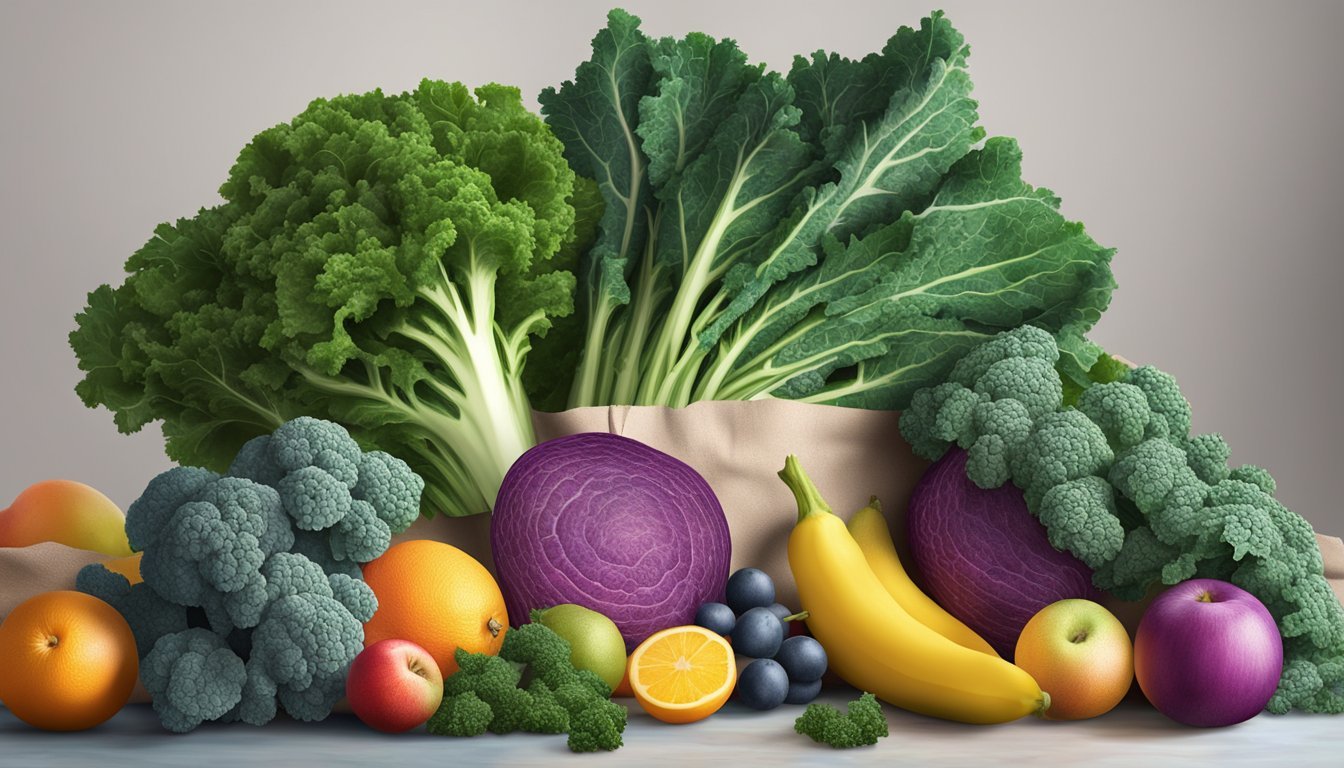Frozen vs Fresh Kale: A Comprehensive Comparison of Nutrition and Uses
Kale has become a popular superfood, packed with nutrients and versatile in the kitchen. Many wonder whether frozen or fresh kale is the better option. Both frozen and fresh kale offer similar nutritional benefits, with frozen kale providing convenience and a longer shelf life.
Freezing kale is a simple process that can be done at home. Washing, drying, and removing stems before freezing helps preserve quality. Blanching kale briefly before freezing can help maintain color and texture for up to 6-12 months in the freezer. Frozen kale works well in cooked dishes like soups, stews, and stir-fries.
Fresh kale provides more versatility for raw preparations like salads. It also allows for selection of preferred varieties and quality at the store or farmers market. However, fresh kale has a shorter shelf life and requires more preparation before use. Ultimately, incorporating either form of kale into one's diet can boost nutrient intake and culinary options.
Benefits of Kale
Kale offers a wealth of nutritional advantages and potential health benefits. This leafy green vegetable is packed with essential nutrients and compounds that support various bodily functions.
Nutritional Profile
Kale is a nutrient powerhouse. It contains high levels of vitamins A, C, and K. A single cup of raw kale provides over 20% of the recommended daily intake of vitamin A, crucial for eye health and vision. Kale is also rich in minerals like potassium and calcium.
The fiber content in kale is noteworthy. One cup of fresh kale contains about 0.8 grams of fiber, supporting digestive health. Kale retains its fiber content even when frozen, making both fresh and frozen options beneficial.
Kale is low in calories, with only 7.2 calories per cup of raw kale. This makes it an excellent choice for those looking to maintain or lose weight while still getting essential nutrients.
Health Implications
Kale's nutrient density contributes to various health benefits. Its high vitamin C content supports collagen synthesis and acts as an antioxidant, protecting cells from damage. This may help boost immune function and promote skin health.
The fiber in kale may aid in lowering cholesterol levels. Regular consumption of kale and other fiber-rich foods has been linked to reduced risk of heart disease.
Kale's antioxidants, including beta-carotene and vitamin C, may help reduce inflammation in the body. This could potentially lower the risk of chronic diseases such as certain cancers and cardiovascular conditions.
The vitamin K in kale is essential for blood clotting and bone health. One serving of kale can provide more than the daily recommended intake of this vital nutrient.
Selecting Quality Kale
Choosing high-quality kale is essential for optimal flavor and nutrition. Pay attention to leaf color, texture, and stem condition to ensure you select the best kale available.
Identifying Freshness
Look for kale with deep green leaves that appear crisp and vibrant. Avoid bunches with yellowing or browning edges, as these indicate age. The leaves should feel firm and sturdy, not limp or wilted.
Examine the stems closely. Fresh kale has firm, crisp stems without any signs of splitting or drying out. Tough stems can be a sign of older kale.
Check for any holes or discoloration on the leaves, which may indicate pest damage or disease. Fresh kale should have a clean, slightly sweet smell. Avoid bunches with any off odors.
For pre-packaged kale, inspect the bag for excess moisture or condensation. This can lead to rapid spoilage. Choose packages with minimal moisture inside.
When selecting frozen kale, look for packages without ice crystals or freezer burn. These signs suggest the kale has thawed and refrozen, potentially affecting quality.
Preparation Techniques
Proper preparation is crucial for preserving kale's nutrients and texture when freezing. Two key steps are washing and chopping the leaves, followed by blanching to maintain color and quality.
Washing and Chopping
Start by thoroughly rinsing kale leaves under cold running water to remove dirt, debris, and potential insects. Use a salad spinner or clean towels to dry the leaves completely. Remove any tough, woody stems and cut them into 1-inch pieces if desired. Tear or chop the leaves into manageable sizes based on your preferences and intended use.
For easier portioning later, consider pre-measuring the kale into recipe-sized amounts before freezing. This step saves time and reduces waste when cooking with frozen kale.
Blanching Kale
Blanching is essential for maintaining kale's vibrant green color and crisp texture during freezing. Bring a large pot of water to a rolling boil. Submerge the prepared kale leaves in small batches for 2-3 minutes. Use a slotted spoon to quickly transfer the blanched kale to a bowl of ice water.
This rapid cooling stops the cooking process and helps retain nutrients. After 2-3 minutes in the ice bath, drain the kale thoroughly. Pat dry with clean towels or use a salad spinner to remove excess moisture. Properly blanched and dried kale is now ready for freezing, ensuring optimal quality and flavor preservation.
Preservation Methods
Kale can be preserved using various methods to extend its shelf life and maintain nutritional value. Freezing is a popular and effective technique for long-term storage.
Freezing Kale
Freezing kale is a simple process that retains most of its nutrients. Start by washing the leaves thoroughly and removing the tough stems. Blanch the kale in boiling water for 2-3 minutes, then immediately plunge into ice water to stop the cooking process. Pat the leaves dry and chop if desired.
Spread the kale in a single layer on a baking sheet and freeze until solid. Transfer the frozen kale to freezer bags or containers. For convenience, portion the kale into ice cube trays before freezing. This method works well for adding to smoothies or soups later.
A vacuum sealer can be used to remove air and prevent freezer burn, extending the kale's quality for up to 8-10 months.
Storage Tips
Proper storage is crucial for maintaining the quality of frozen kale. Label containers with the date of freezing to track freshness. Use within 6 months for best flavor and texture.
Store frozen kale at 0°F (-18°C) or below. Avoid frequent temperature fluctuations by keeping kale in the back of the freezer where it's coldest.
When ready to use, thaw kale in the refrigerator overnight or add directly to recipes like soups or stews. Frozen kale works well in cooked dishes but may not be suitable for raw applications like salads.
For longer storage, consider dehydrating kale. Dried kale can be stored in airtight containers for up to a year and easily rehydrated for use in various recipes.
Incorporating Kale into Meals
Kale's versatility makes it an excellent addition to various dishes. Its robust flavor and nutritional benefits can enhance both fresh and frozen preparations.
Recipes for Fresh Kale
Fresh kale shines in salads and as a crispy snack. Massage raw kale with olive oil and lemon juice for a tender salad base. Add dried cranberries, sliced almonds, and a light vinaigrette for a refreshing meal.
For a healthier alternative to potato chips, try making kale chips. Toss kale leaves with olive oil and seasonings, then bake until crisp. They make a satisfying, nutrient-dense snack.
Kale pesto offers a twist on the classic basil version. Blend blanched kale with garlic, pine nuts, Parmesan cheese, and olive oil. Use it as a pasta sauce or spread.
In egg dishes, kale adds color and nutrition. Incorporate it into frittatas or omelets with goat cheese for a savory breakfast option.
Recipes for Frozen Kale
Frozen kale is convenient for quick meal prep. It's perfect for smoothies, providing a nutritional boost without affecting taste. Blend it with banana, berries, and Greek yogurt for a creamy green smoothie.
Soups and stews benefit from frozen kale's easy incorporation. Add it to butternut squash soup for extra fiber and nutrients. It pairs well with white beans and sausage in hearty stews.
For a simple side dish, sauté thawed and drained frozen kale with garlic and olive oil. Season with salt, pepper, and a squeeze of lemon juice.
Frozen kale puree can be stirred into pasta sauces, mixed into mashed potatoes, or added to casseroles for a nutrient boost without changing the texture significantly.
Additional Tips
Maximizing the potential of kale involves more than just proper storage. These tips will help you enhance its flavor and incorporate it into your diet in creative, delicious ways.
Enhancing Flavor
Massage raw kale with a bit of olive oil and lemon juice to soften the leaves and reduce bitterness. This technique works for both fresh and thawed frozen kale. Add garlic, red pepper flakes, or balsamic vinegar for extra flavor.
Pair kale with complementary ingredients like nuts, fruits, or cheese. Toasted pine nuts, dried cranberries, or crumbled feta can elevate a simple kale salad.
For cooked dishes, sauté kale with aromatic herbs and spices. Cumin, smoked paprika, or fresh ginger can transform its taste profile.
When using frozen kale, add it directly to soups, stews, or stir-fries without thawing. This preserves its texture and nutrients.
Healthy Snacking
Transform kale into crispy chips for a nutritious snack. Toss fresh or thawed kale leaves with olive oil and seasonings, then bake until crisp.
Blend frozen kale into green smoothies for a quick nutrient boost. Its mild flavor pairs well with fruits like bananas or berries.
Create kale pesto by blending the leaves with nuts, garlic, and olive oil. Use it as a spread or sauce for added flavor and nutrition.
Incorporate kale into homemade energy bars or bites. Mix chopped kale with nuts, seeds, and dried fruit for a portable, nutrient-dense snack.




